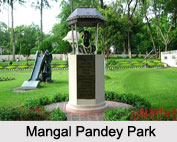 Barrackpore which is also known as Barrackpur is the prime location of the one and only Military Cantonment and Police Training Academy in West Bengal. From the rule of British East India Company and the British Empire in India, Barrackpur shares the medieval and modern past to the contemporary people.
Barrackpore which is also known as Barrackpur is the prime location of the one and only Military Cantonment and Police Training Academy in West Bengal. From the rule of British East India Company and the British Empire in India, Barrackpur shares the medieval and modern past to the contemporary people.
Naming of Barrackpur
Barrackpur got its name as it was the site of the first cantonment of the British East India Company. Ain-i-Akbari suggested that the name comes from "Barbakpur", while Bipradas Pipilai referred this place as Chanak.
History of Barrackpur
History of Barrackpur traced back from the Greek navigators, geographers, chronicles and historians of the 1st century BC to the 3rd century AD. In the medieval era, it was known as “Chanak†From the late medieval era, Barrackpur or Barrackpore was ruled over by a line of Zamindars based in Nona Chandanpukur. After the decline of Nawabs of Bengal, British barrack or cantonment was built in Barrackpur in 1772. In 1857, Barrackpore saw the Indian rebellion of 1857, where Mangal Pandey came in the limelight. British Government in India later began to develop Barrackpur for their trade. 
Geography of Barrackpur
The latitudinal and longitudinal limit is 22.76 degree North to 88.37 degree East. Barrackpur is located in the Ganga River-Brahmaputra River delta region. This region is located in the North 24 Parganas district of West Bengal. The average elevation of Barrackpur is 15 metres. Barrackpur is positioned on the eastern bank of the Ganga.
Demography of Barrackpur
According to Population Census in the year 2011, Barrackpur had a population of 144,331. The men constitute 53 percent while the female consists of 47 percent.
Education of Barrackpur
Ramakrishna Vivekananda Mission School, Barrackpore Rastraguru Surendranath College, Mahadevananda Mahavidyalaya, St. Mary`s Technical Campus, Adamas International School, Douglas Memorial Higher Secondary School, Army Public School Barrackpore, Kendriya Vidyalaya Barrackpore Army are the popular educational hubs there.
Economy of Barrackpur
 Jute, engineering, paper, and cotton are popular in production. Barrackpore has also small scale cottage industry and handicraft sector. Floriculture, pisciculture and horticulture have also flourished in Barrackpur.
Jute, engineering, paper, and cotton are popular in production. Barrackpore has also small scale cottage industry and handicraft sector. Floriculture, pisciculture and horticulture have also flourished in Barrackpur.
Culture in Barrackpur
The culture in Barrackpur defines the Hindu cult of modern era. Different Hindu festivals are celebrated here.
Tourism in Barrackpur
Temples of Panihati, Modern Temples of Khardaha, Ichhapur Defence Estate, Army Cantonment, Dhobi Ghat, Tomb of Lady Canning, Flagstaff House, Mangal Pandey Memorial Park, Gandhi Ghat are the popular tourist delights there.
Visiting Information
Barrackpur is connected with all the major cities in West Bengal. This city is connected with Kolkata through roadways and railways. Regular trains are available from Sealdah to reach there which connects Bongaon, Bandel and other cities of West Bengal. B.T. Road is the oldest metal road in India that connects Barrackpore to Kolkata.



















